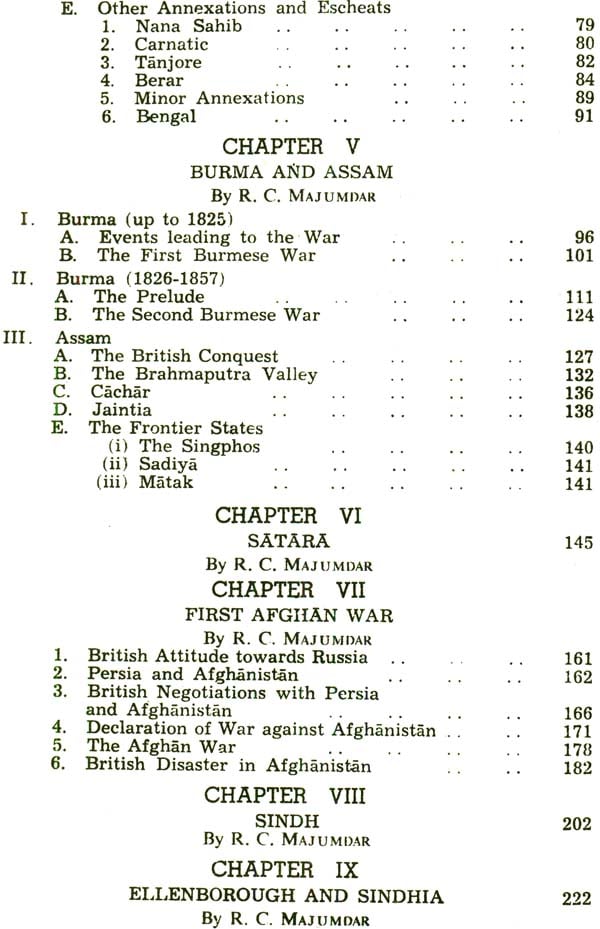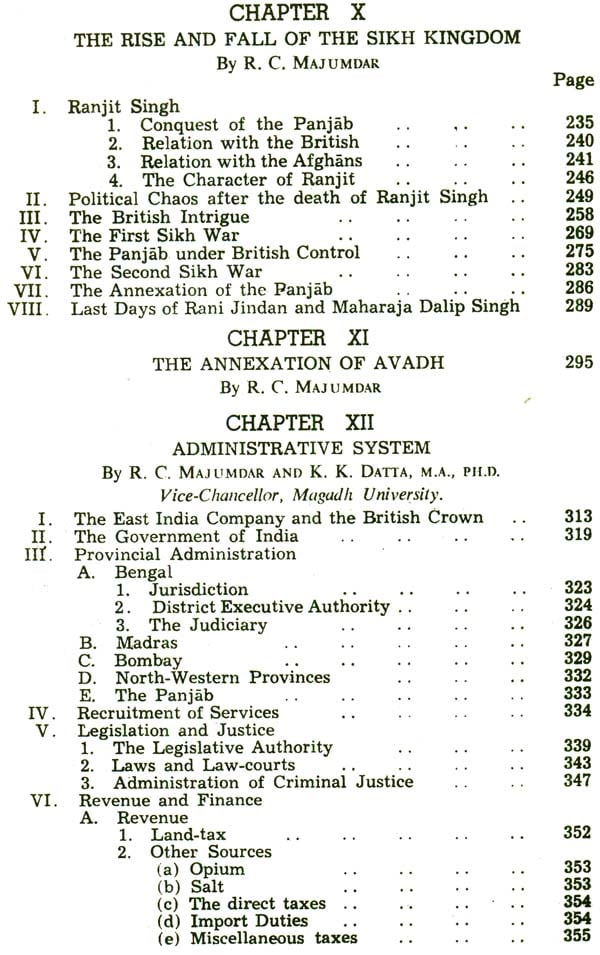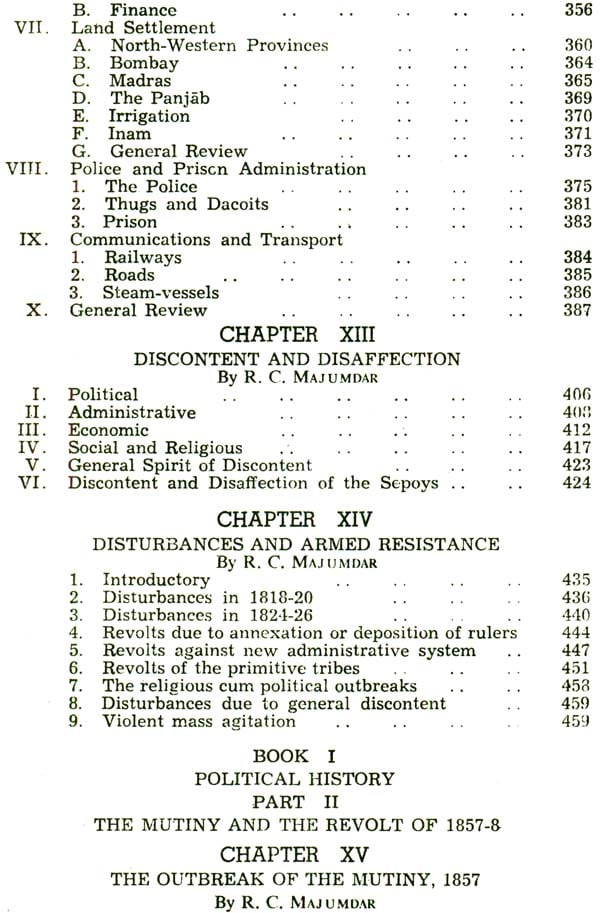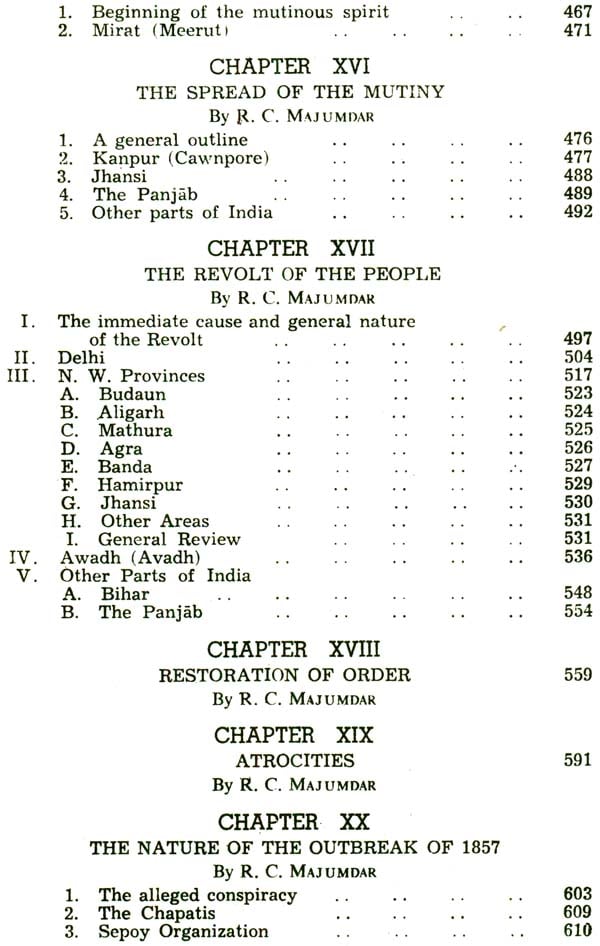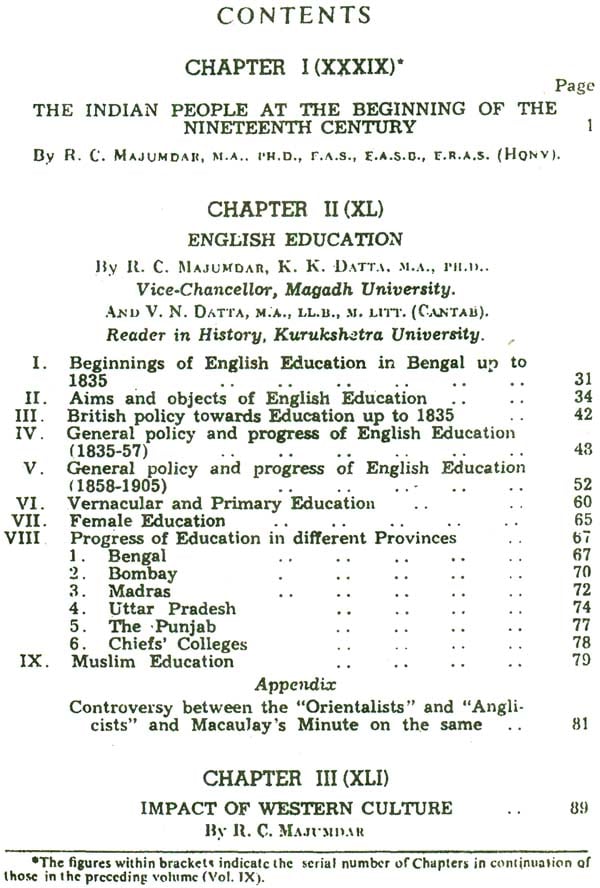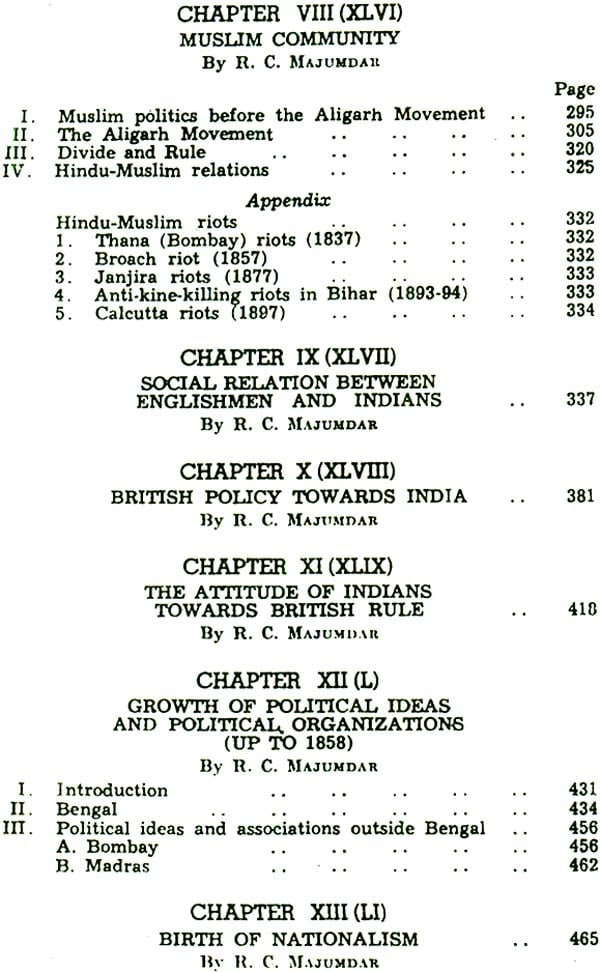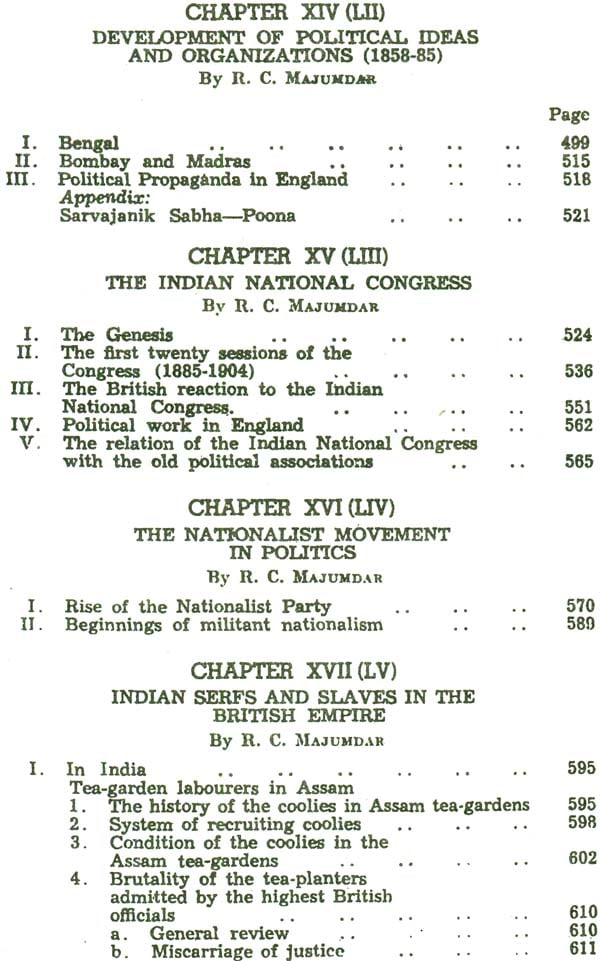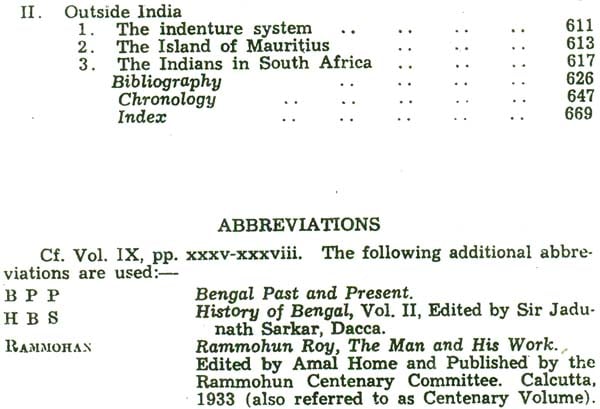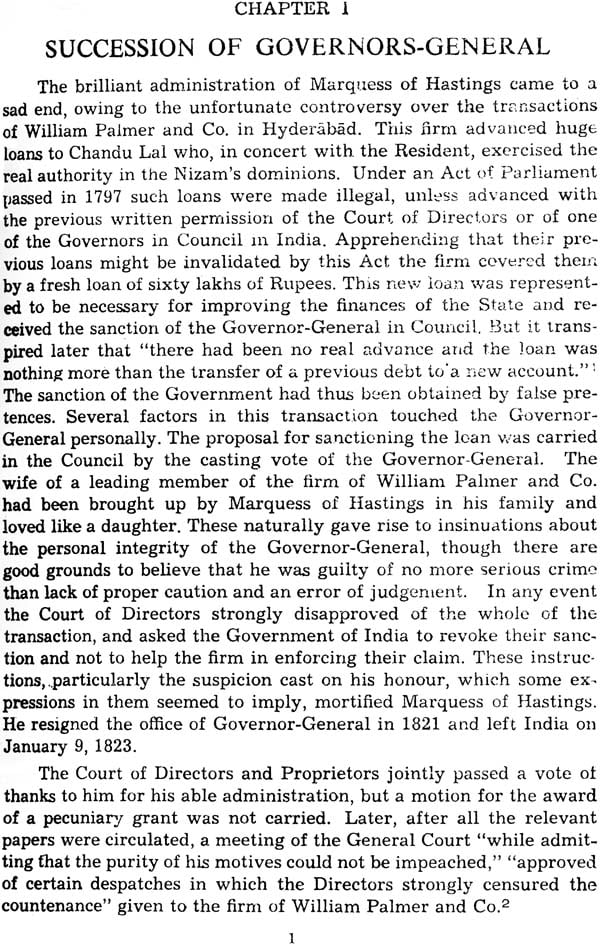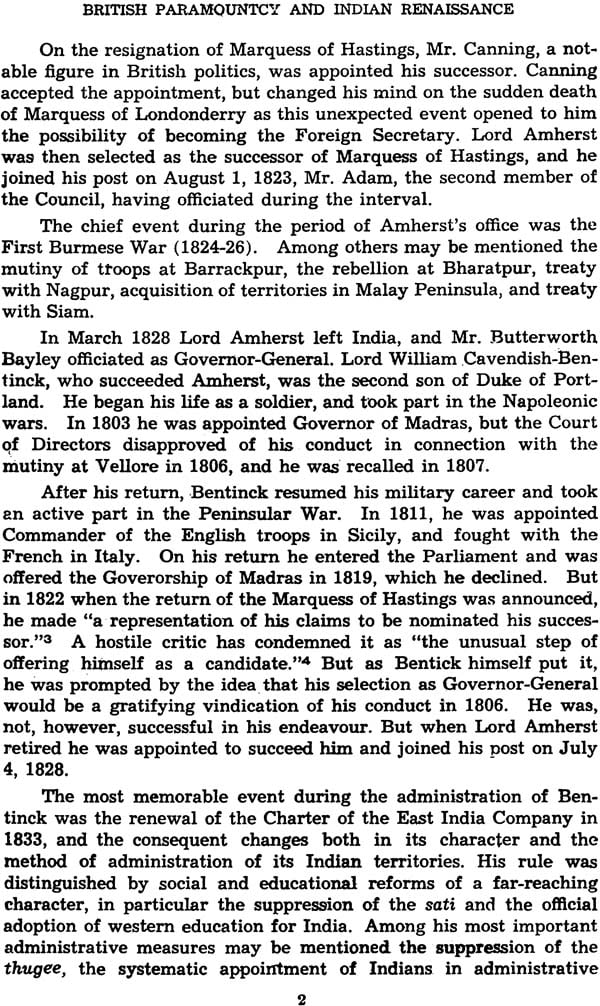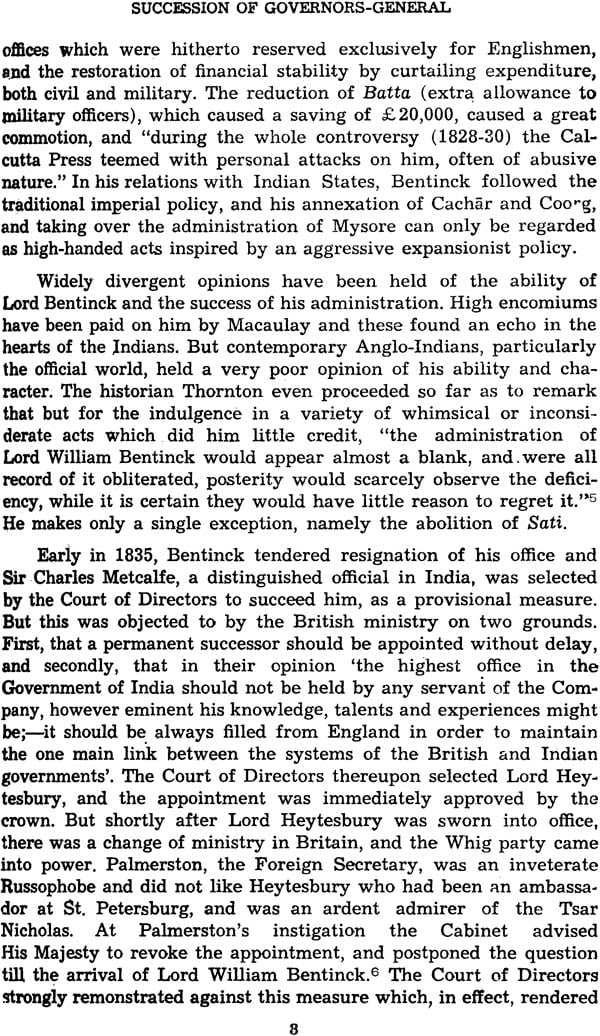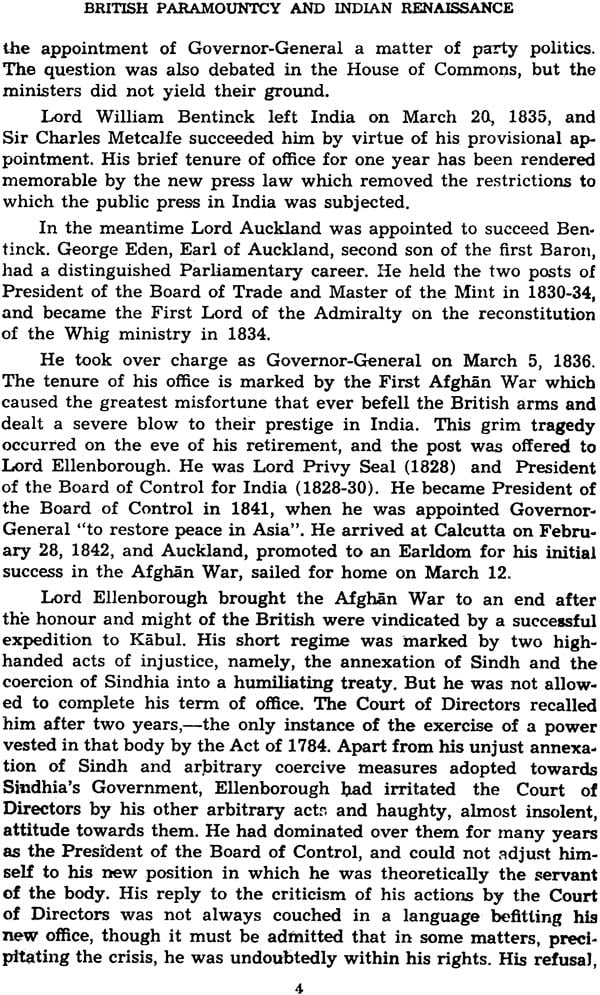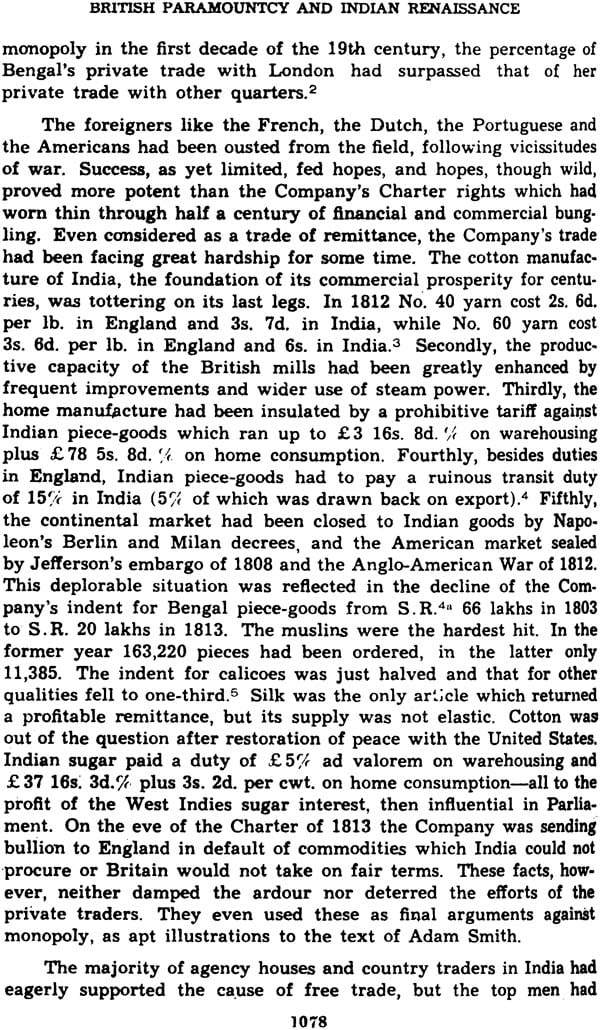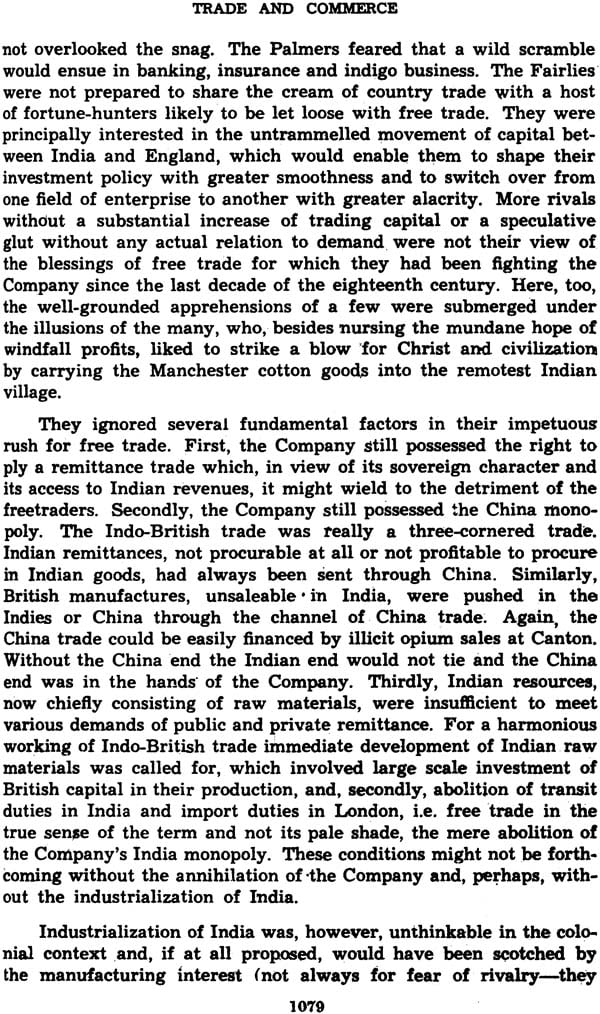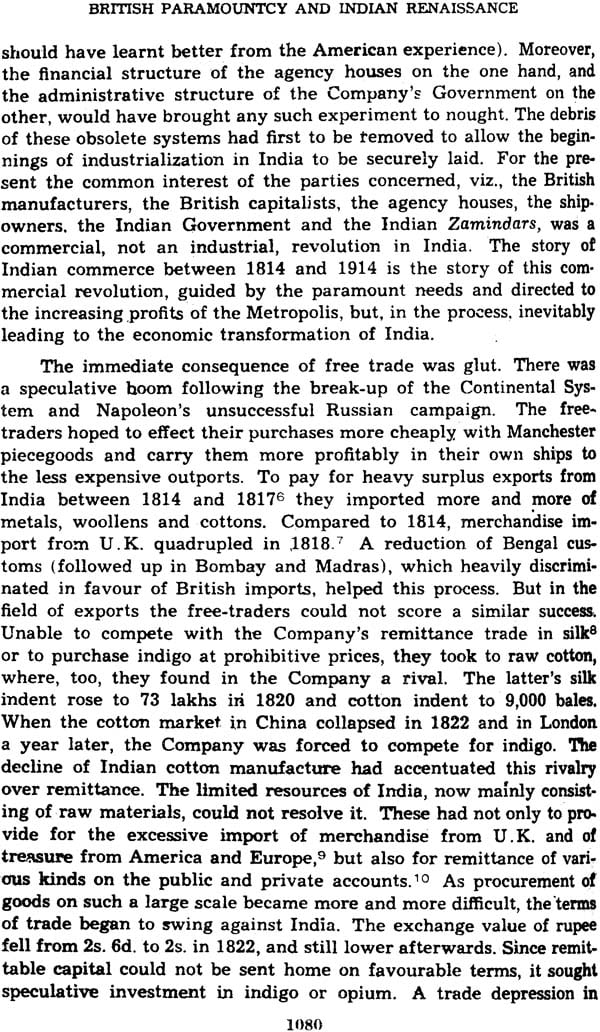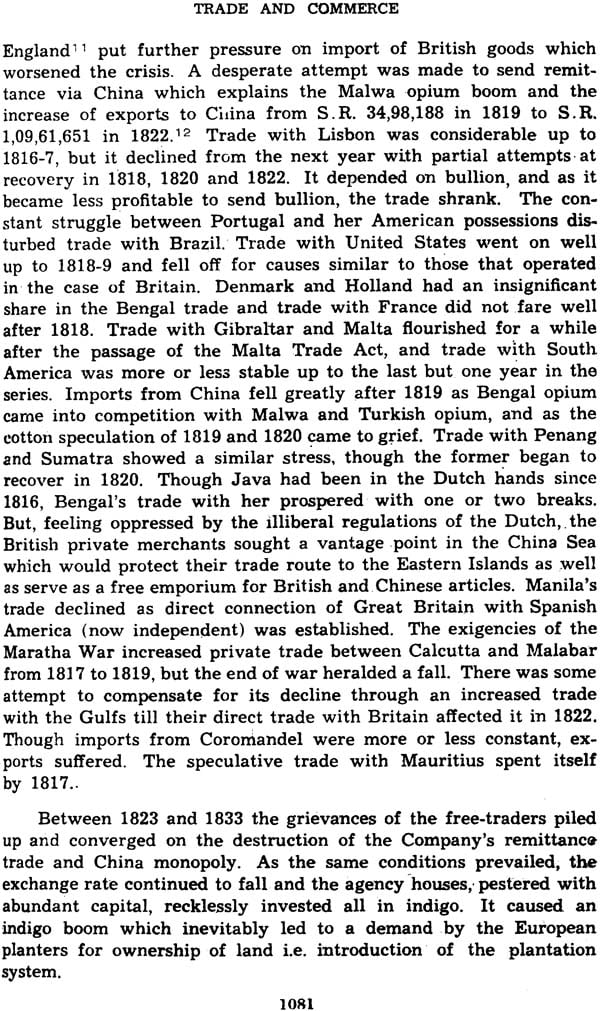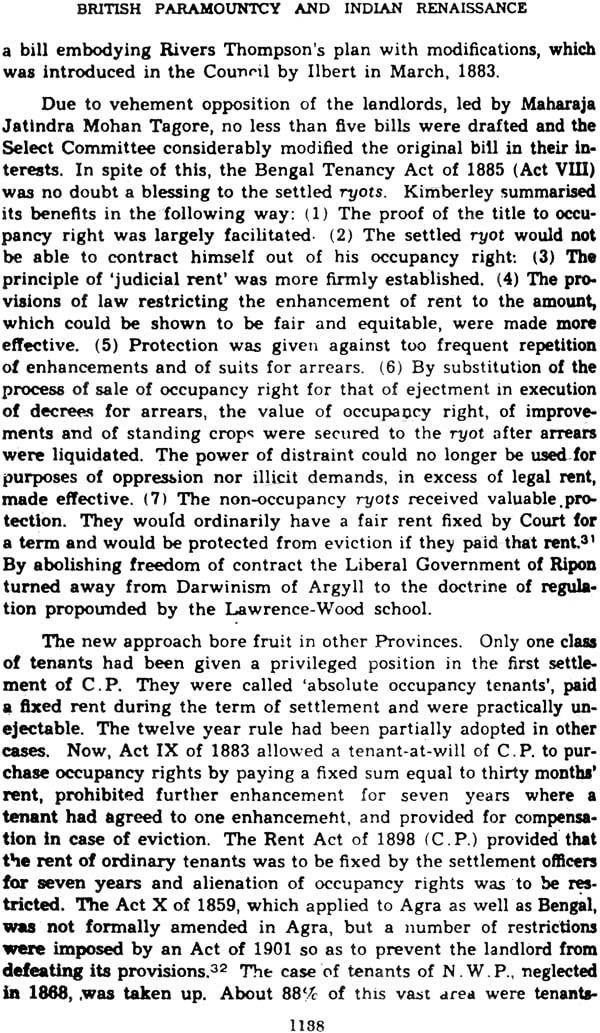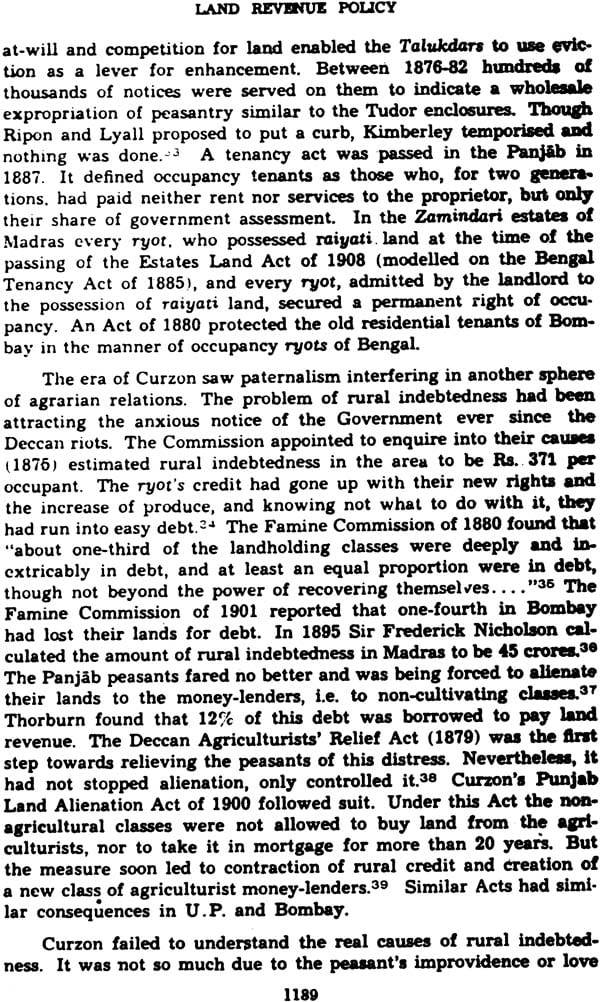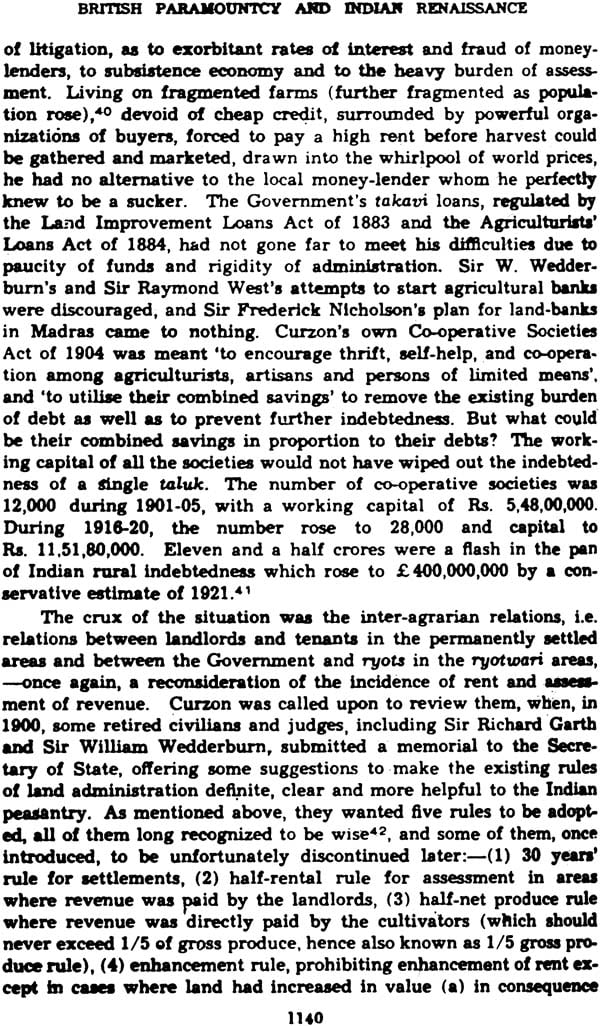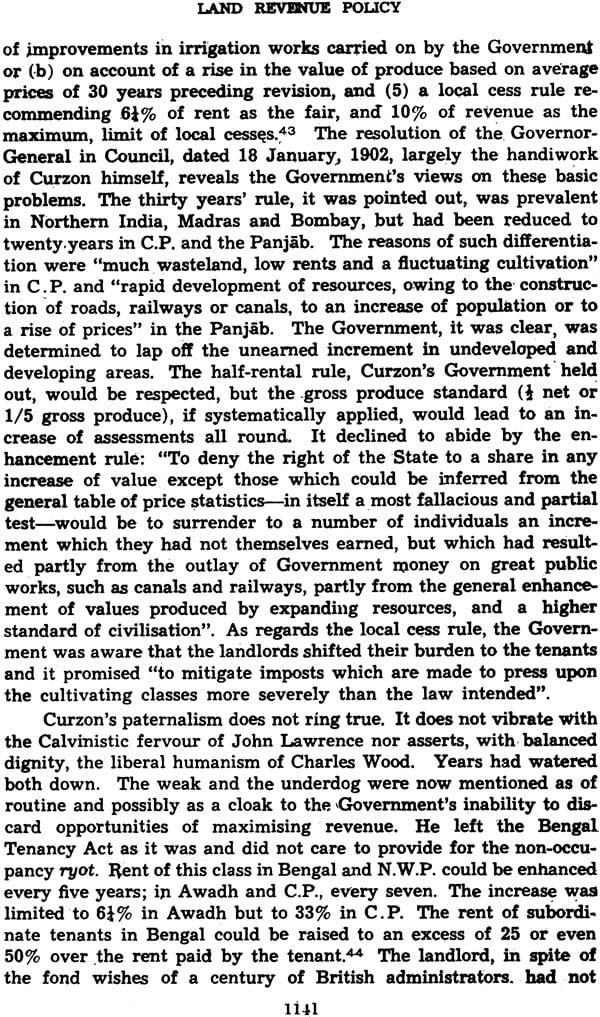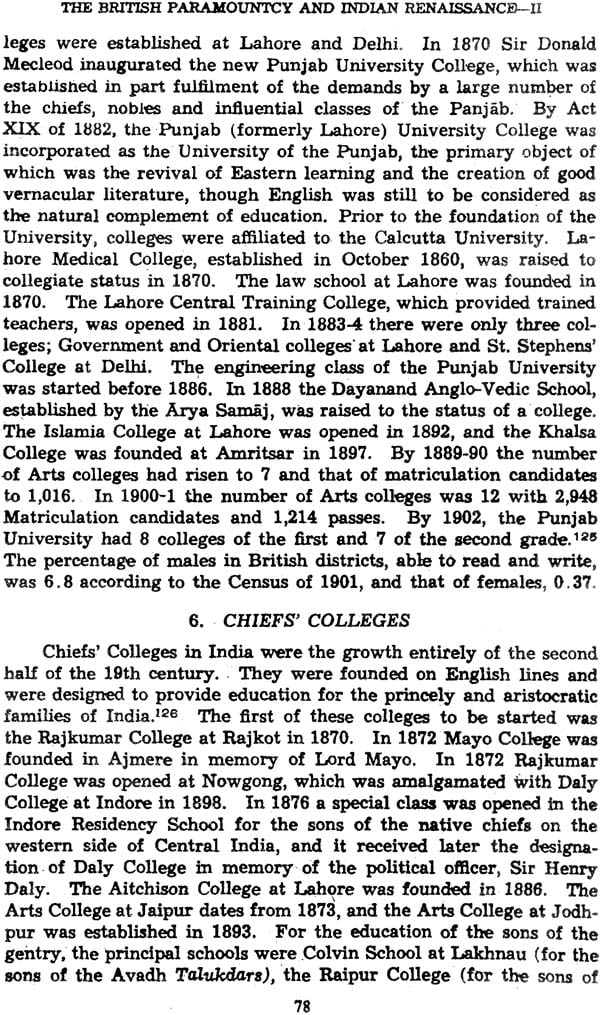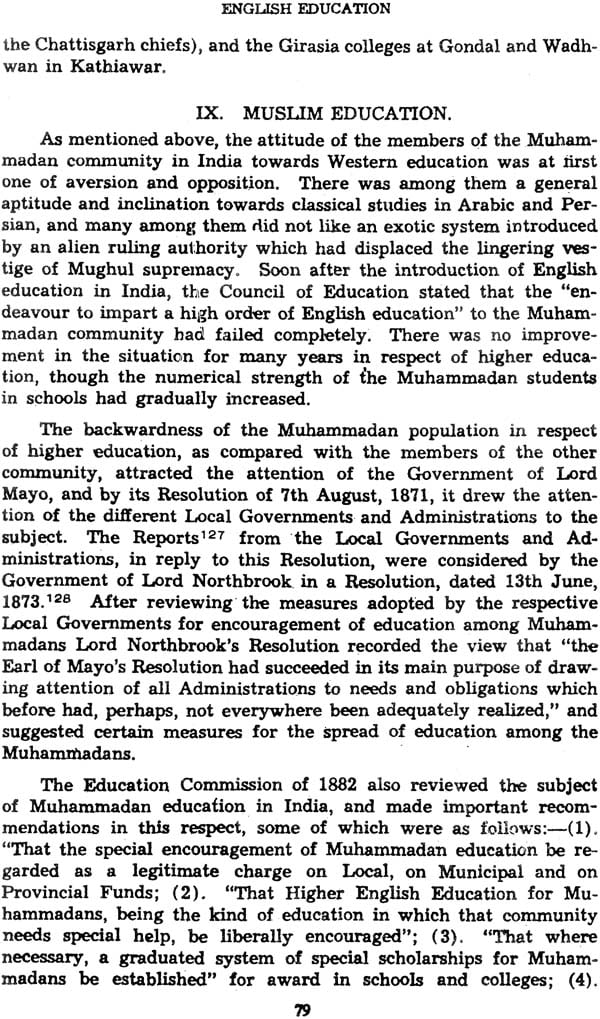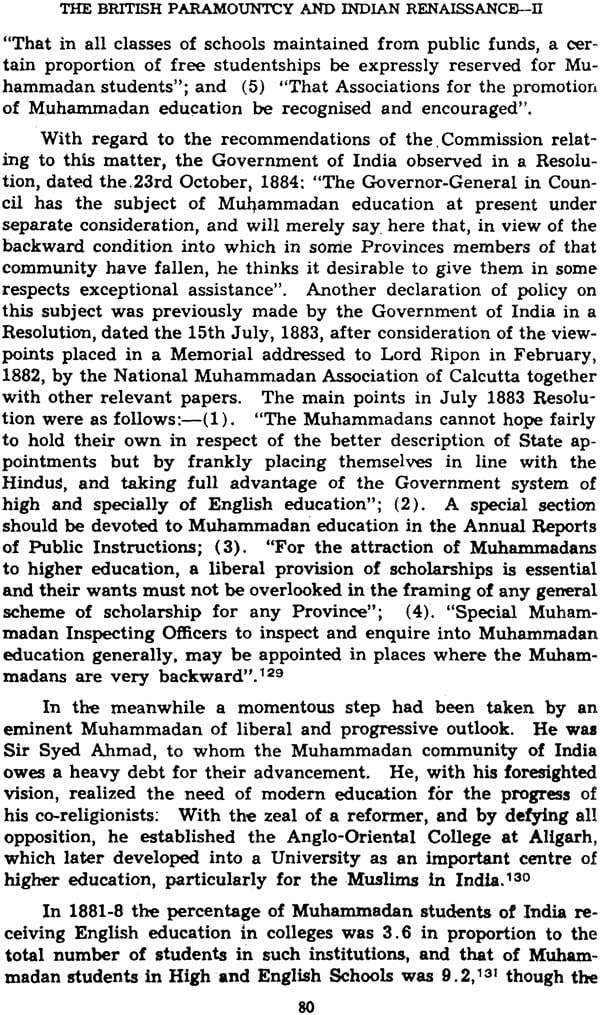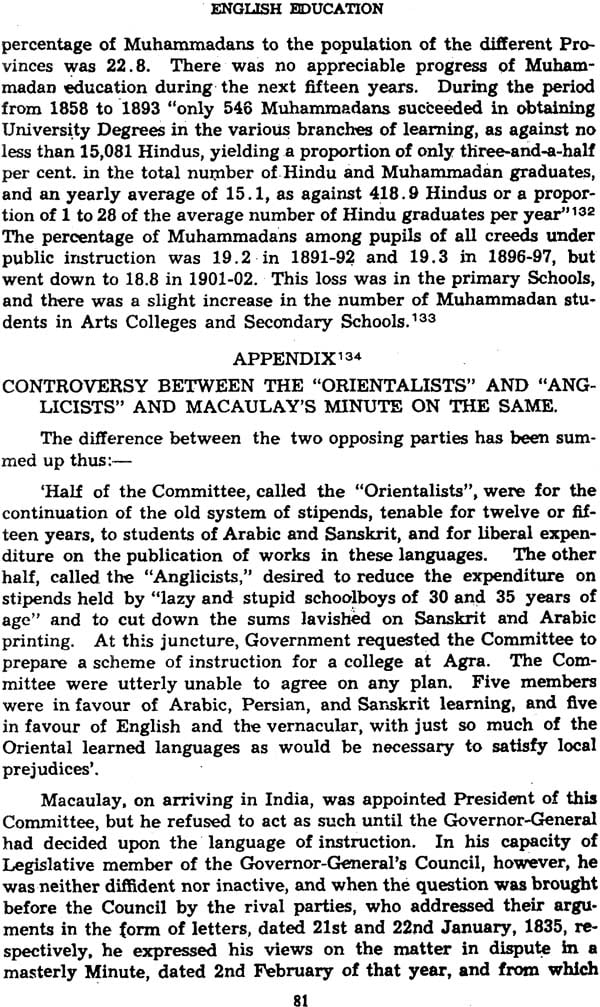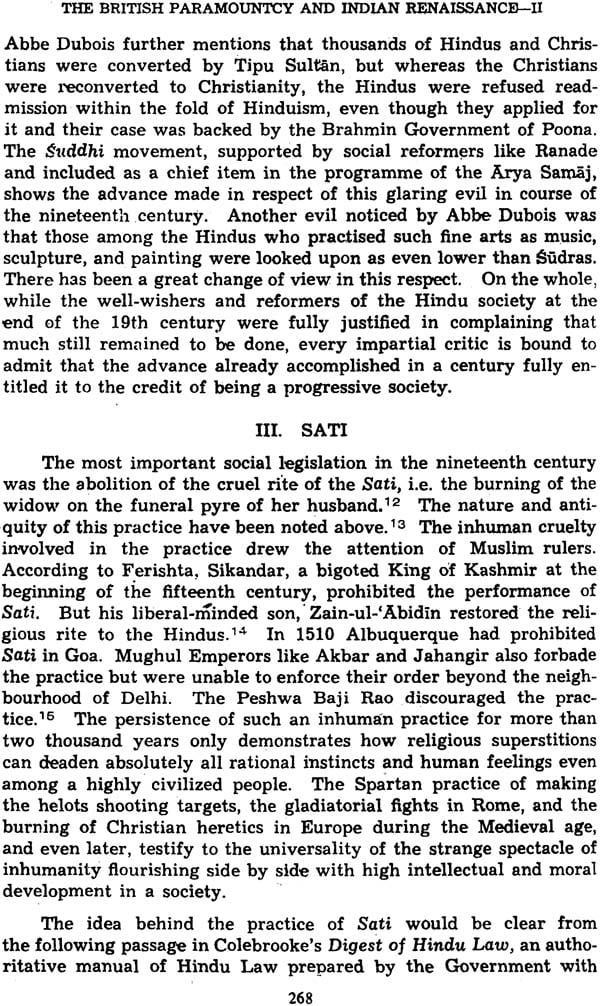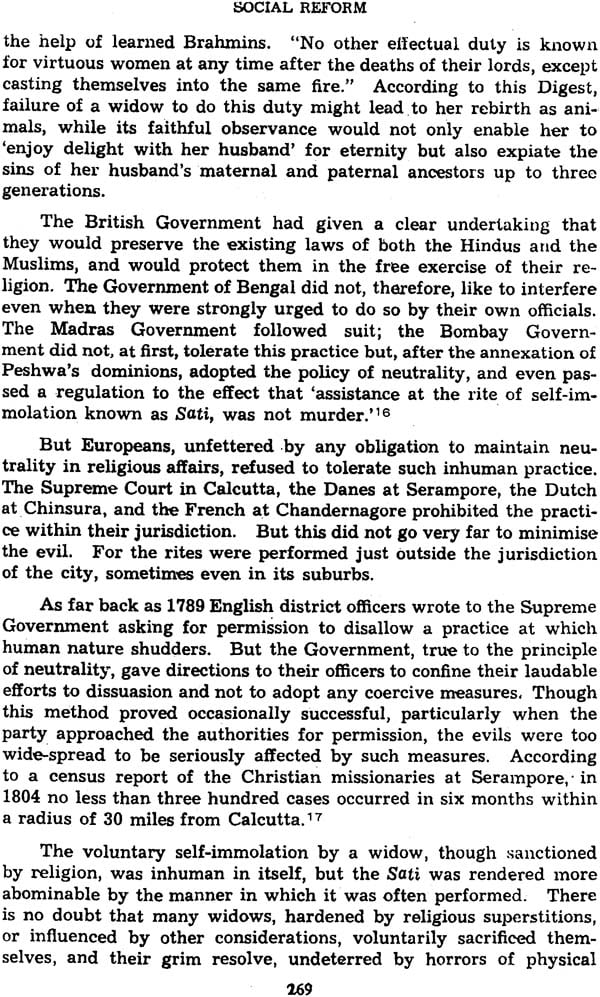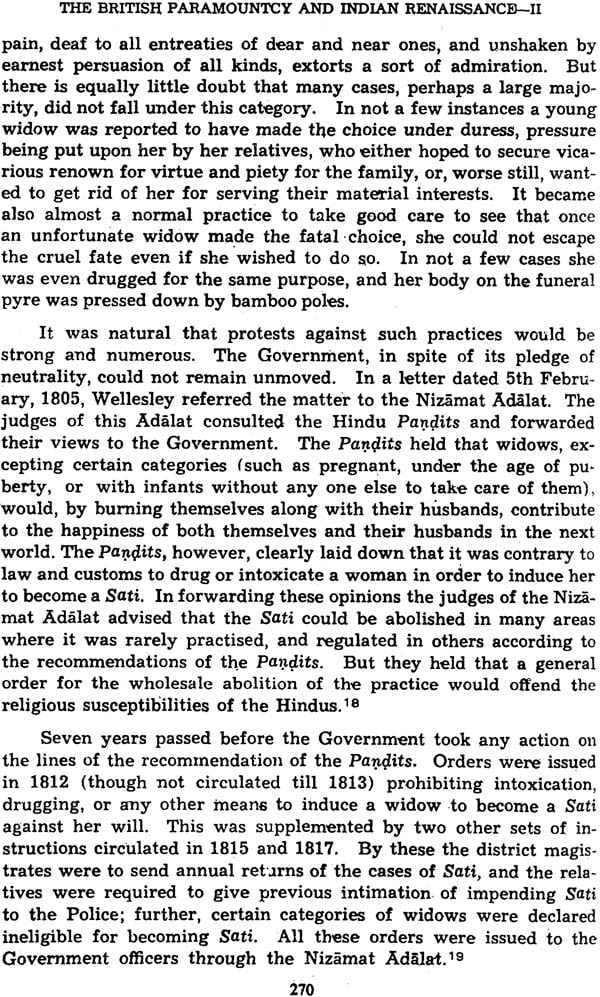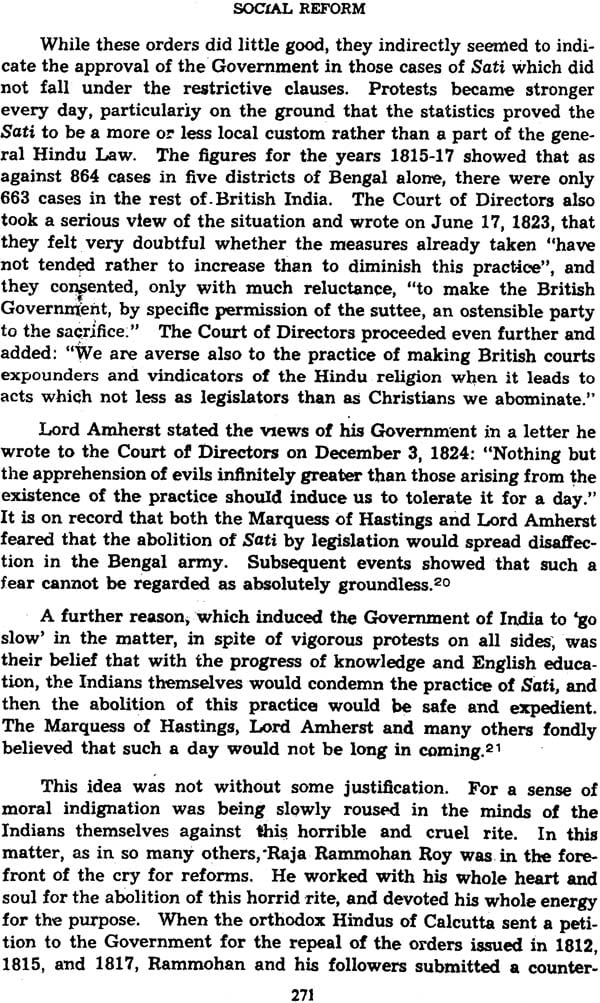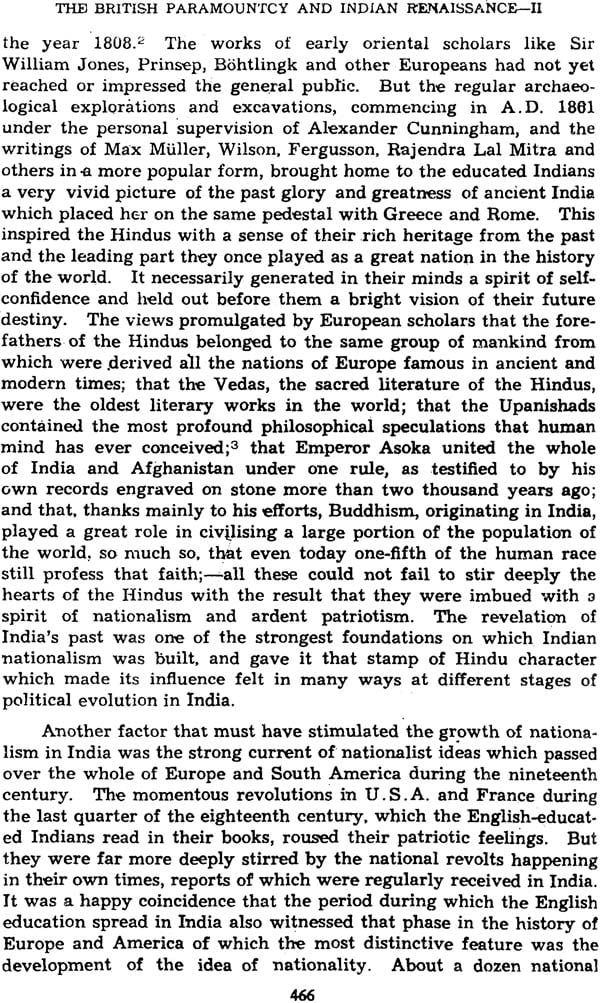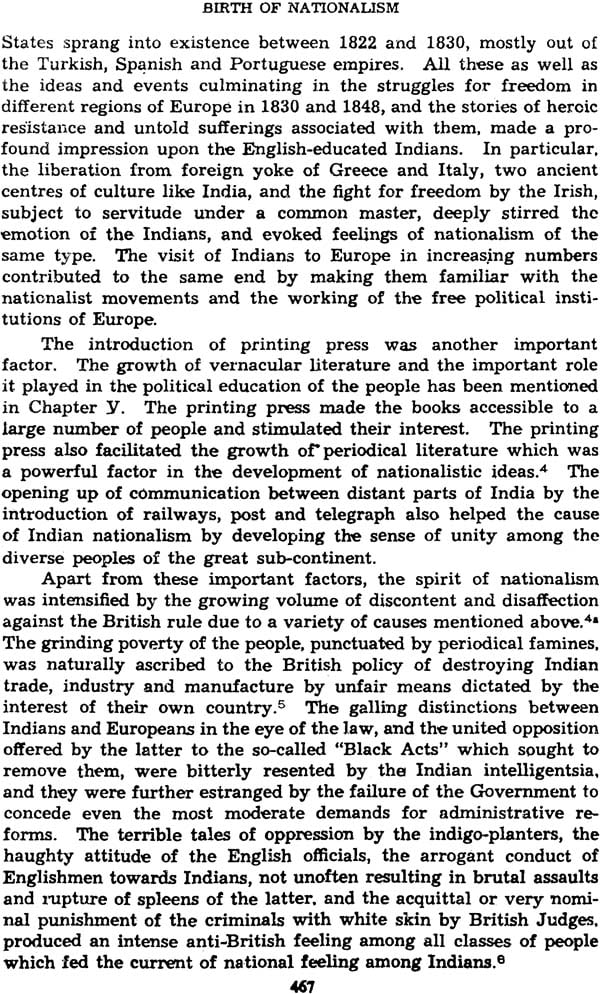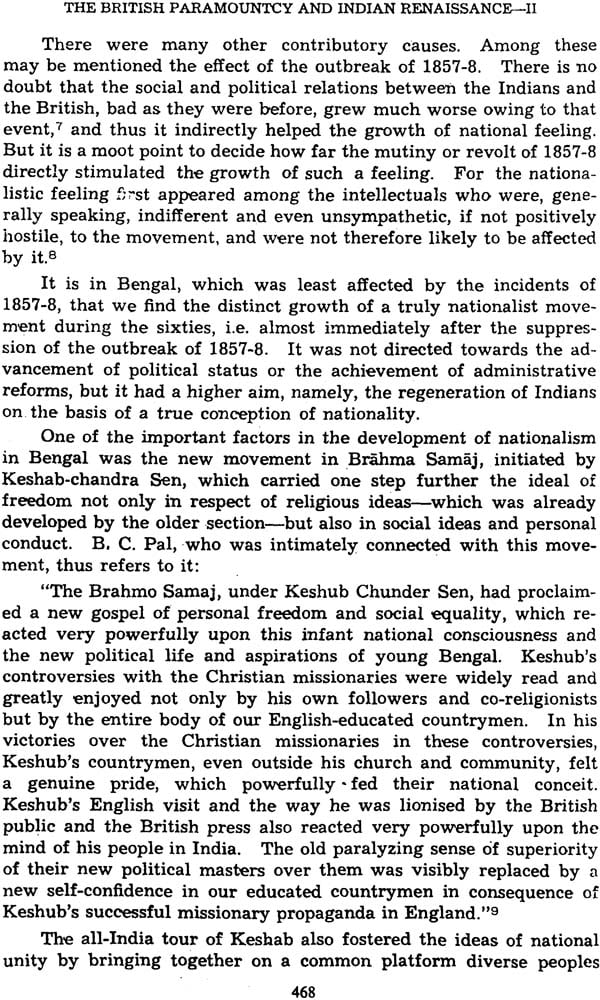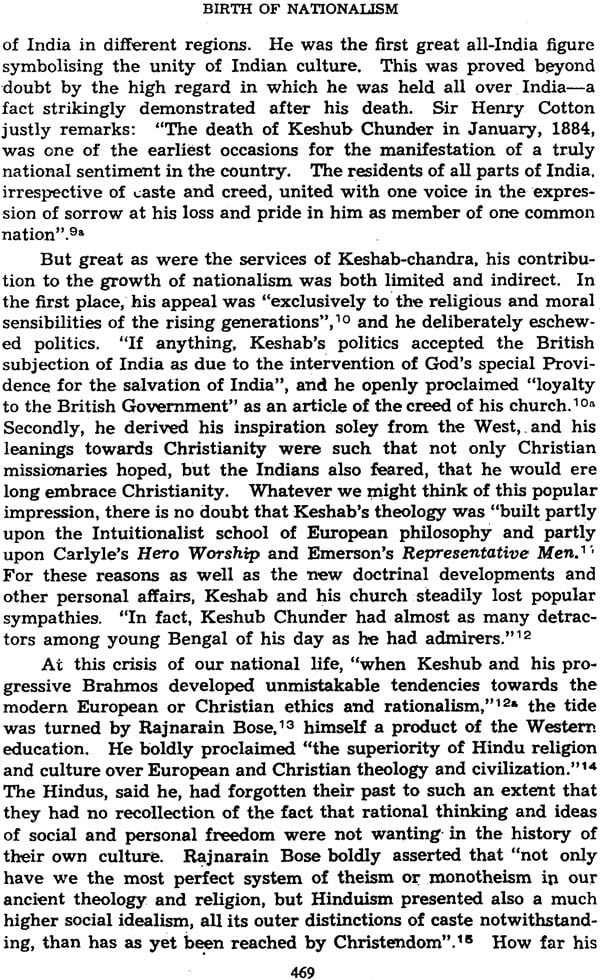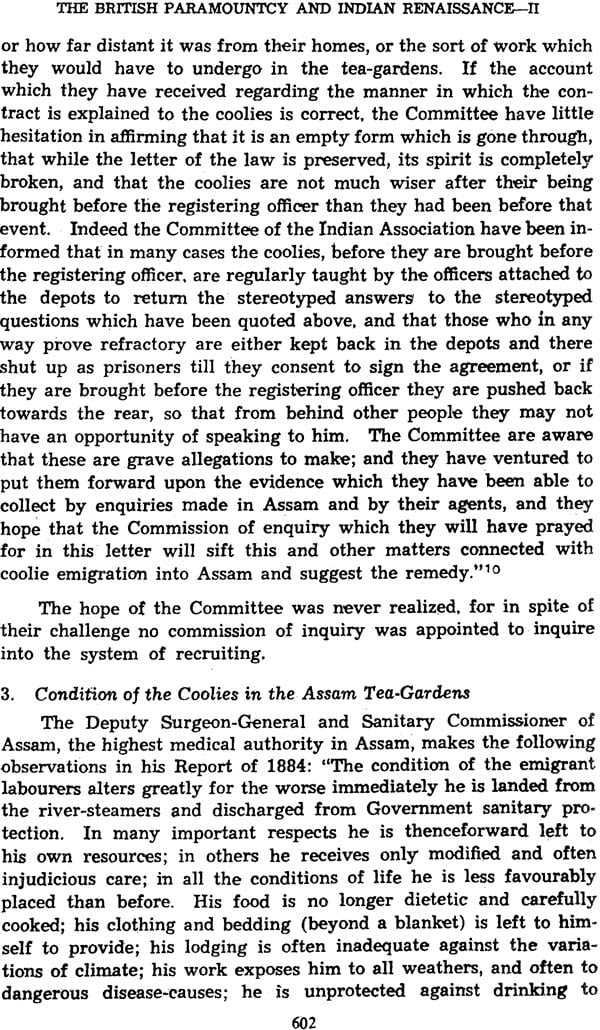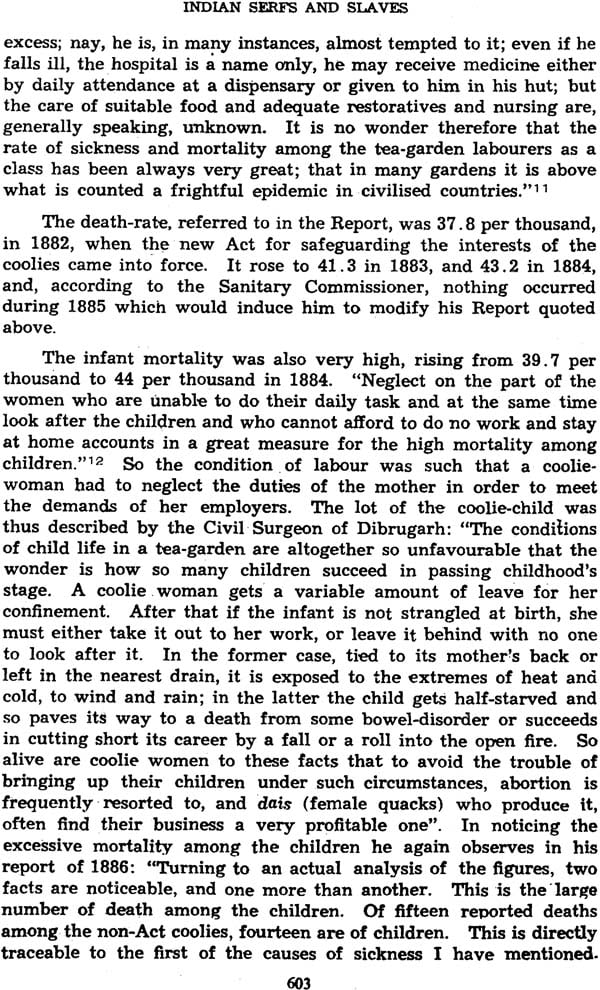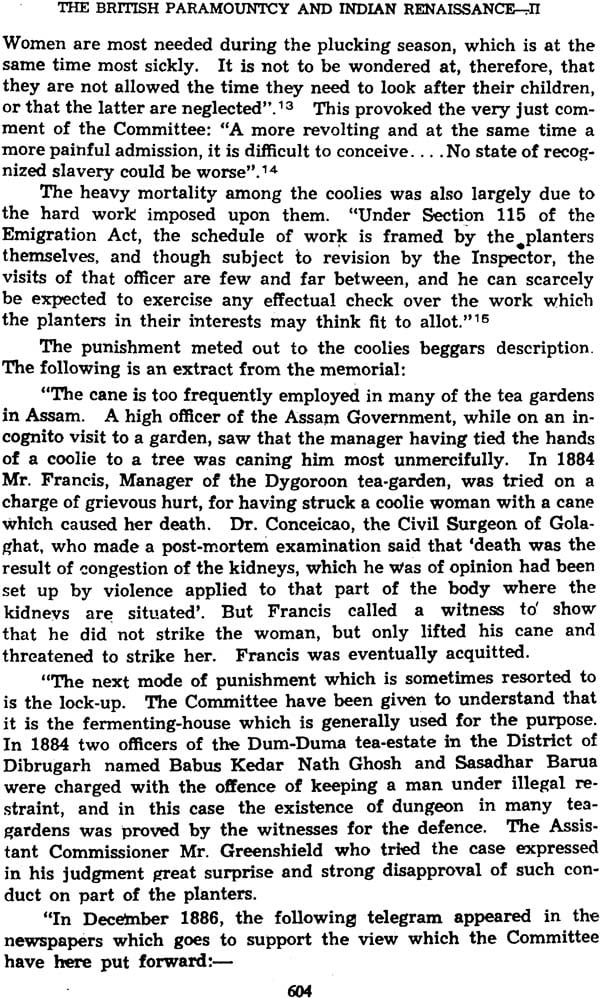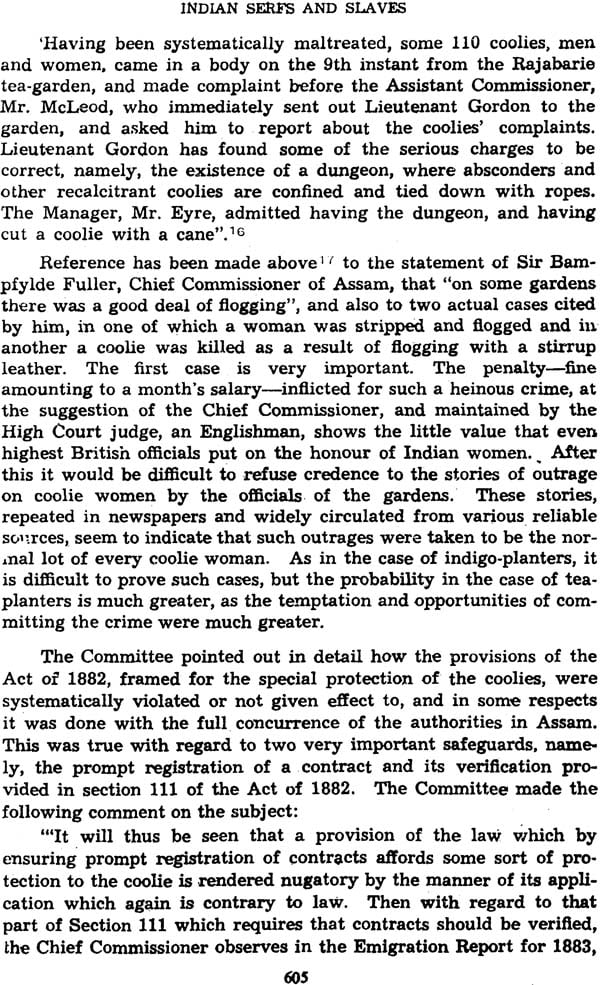
British Paramountcy and Indian Renaissance: The History and Culture of the Indian People (Set of 2 Parts)
Book Specification
| Item Code: | NAI199 |
| Author: | R.C. Majumdar |
| Publisher: | Bharatiya Vidya Bhavan |
| Language: | English |
| Edition: | 2018 |
| Pages: | 1946 |
| Cover: | Hardcover |
| Other Details | 9.5 inch x 6.5 inch |
| Weight | 3 kg |
Book Description
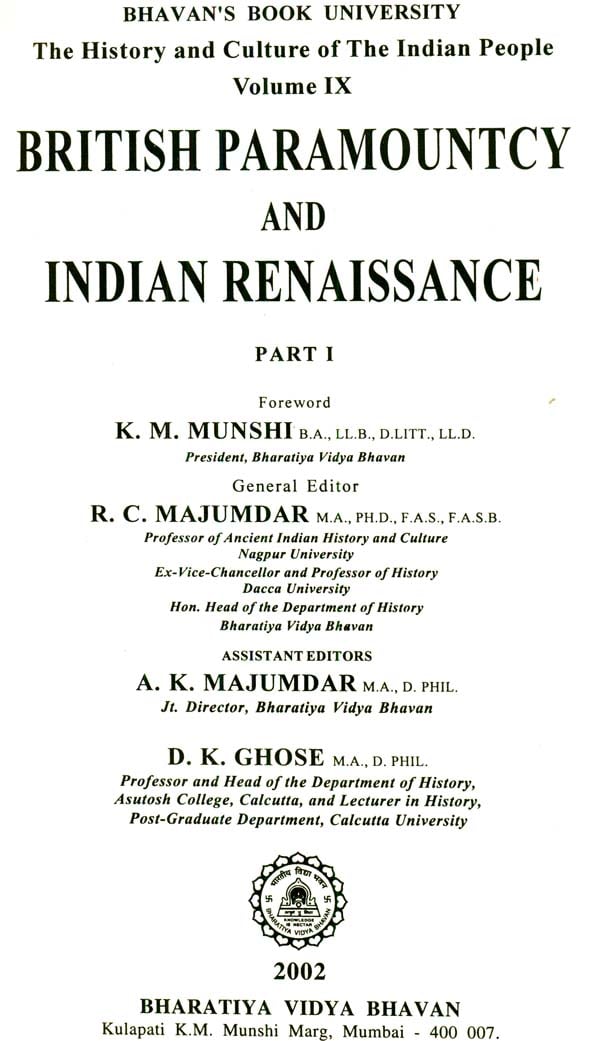
<meta content="text/html; charset=windows-1252" http-equiv="Content-Type" /> <meta content="Word.Document" name="ProgId" /> <meta content="Microsoft Word 12" name="Generator" /> <meta content="Microsoft Word 12" name="Originator" /> <link href="british paramountcy and india renaissance_files/filelist.xml" rel="File-List" /> <link href="british paramountcy and india renaissance_files/themedata.thmx" rel="themeData" /> <link href="british paramountcy and india renaissance_files/colorschememapping.xml" rel="colorSchemeMapping" /> <!--[if gte mso 9]><xml>
Part I
Preface
Volumes IX and X deal with the history of India from HUG to 1905. These two dates are significant landmarks in the history of Modern India. The establishment of British paramountcy in India was completed in 1818, and the year 1905 marks the beginning of that national struggle by the Indians against the British rule which' culminated in the achievement of independence in 1947. This volume describes the nature of British rule in India for nearly a century after it had become the dominant political power; and the next volume delineates the social changes and cultural renaissance which led to the emergence of India from the Medieval to: the Modern Age, and set in motion those forces and tendencies which created the Indian nation out of heterogeneous groups of peoples. It is hardly necessary to point out that the events described in these two volumes are inextricably mixed up, and they should be looked upon as parts of a single work describing the different aspects of the history of India during the nineteenth century. As a matter of fact, when the plan for the History and Culture of the Indian People was first drawn UJ1 in 1945, only a single volume, namely Vol. IX. was designed to cover all the topics which are now treated in Vols. IX and X.
Vol. IX is divided into two Books which deal, respectively, with the political and economic history of the period. The political history is again divided into three parts; the second part dealing with the mutiny and revolt of 1857-8, and the other two with the periods before and after it.
The political history has been designed to be not a mere chronicle of events, but a broad review of the British rule. bringing out its two main characteristics, namely, the establishment of paramount authority all over India, and the creation of a framework of an allIndia administration on' a solid basis, such as India has probably never known, save under the Maurya and the Mughul Emperors. It also seeks to draw, in true' colour, the colonial imperialism of Britain which forms the real background of British rule in India in the nineteenth century. It omits the meticulous details which are' more suitable for a chronicle or a Gazetteer, and avoids, as far as possible, emphasis on personalities,-Governors-Genera1. military commanders and high Civil Officials-whose individual activities loom large in the current histories of British India.
The materials for writing the history of India in the 19th century are both ample and varied in character. Apart from numerous printed books, pamphlets and periodicals, the very nature of the British Government in India has been of great help to the historians in this respect. Being merely a subordinate body to the superior authority-East India Company up to 1858 and the British Crown thereafter-residing in England, almost every transaction of any importance had ·to be put on record for the examination by the latter, and there was a continuous stream of correspondence, both official and private, between the two. It has furnished invaluable source materials, such as has been seldom the good luck of a historian to possess. The confidential minutes and despatches of the Governors General and the Court of Directors or Secretary of State, as well as private correspondence between them, have thrown very interesting light on the inner motives that inspired the British policy and activities in India. They have also supplied positive evidence as to the real nature of many aspects of British imperialism, and thrown off the mask of benevolence under which it was successfully hidden for a long time. As more and more of these records are gradually being thrown open to the public, the historian has been in a position to rearrange the different elements of British policy in India properly in order to draw up an integrated picture of the British rule in India in the 19th century.
A very valuable, supplement to these private and confidential official documents is supplied by the speeches and writings of a few liberal-minded Englishmen who felt real sympathy for Indian aspirations. The adverse comments on the various aspects of British rule in India by Englishmen like George Thompson, John Bright, Henry Fawcett, Sir Charles Digby, Wyndham and Sir Henry Cotton cannot be lightly dismissed as irresponsible criticism dictated by selfish motives, sense of frustration, or an anti-British spirit-insinuations such as are usually made in regard to any unfavourable criticism of British rule by even the highest Indian. The adverse comments on British rule in India by the Britishers themselves are therefore of inestimable value to a historian, when they lend support to Indian criticism which would, otherwise, not carry much weight, having emanated from an interested party with natural repugnance against the British.
The historian of British India has therefore no complaint about lack of materials;-he rather suffers from a plethora of them. It is impossible for a single individual, however industrious he might be, to peruse all the available records of the 19th century. All that he can hope to do is to go through a judicious selection of them, and utilize the monographs written on various aspects of British administration by specialists who based their work on a minute and critical study of all relevant documents on the subject. -There are-many valuable works of this nature, but they are unequal in value and need to be studied with care. For, generally speaking, both British and Indian writers were, more or less, influenced by personal feelings and prejudices, and few could rise above them in order to produce a real objective study.
There are a number of important historical works of a general nature covering the whole or parts of the 19th century, written by contemporary Englishmen. The earliest work relating to the period under review is H. H. Wilson's Supplement, in three volumes, to-the six-volume History of James Mill. This Supplement continues the history of British India from 1805 to 1835. Next comes Thornton's six-volume History of the British Empire in India, covering the period up to nearly 1845 when the last volume was published. Two other less voluminous works are Beveridge's Comprehensive History of India in three volumes, published in 1867, and Trotter's History of the British Empire in India (1844-58), published in 1866. These were not followed by any such comprehensive history. written by a Britisher for more than half a century. It is not a little curious, that although a great deal of fresh materials became available as the years rolled on, no British historian felt inclined to follow in the footsteps of his illustrious predecessors mentioned above, and write a comprehensive history of the glorious achievements of his country in a far distant land. Instead, we find only a small number of short treatises of the nature of advanced text-books. written by Meadows Taylor (1870), Sir Alfred Lyall (1894'), V. A. Smith (1919), P. E. Roberts (1921), and Thompson and Garratt (1934). But scholarly books were written on select topics, primarily with a view to defend British officials and British policy in India against charges levelled by older writers, including. English historians. In general, the historical writings of Englishmen from about the last quarter of the 19th century were, more or less, tinged by the spirit of imperialism which they inherited as a legacy from the British rule in India during the preceding century, The most typical example of such a historical work is furnished by V. A. Smith's Oxford History of India (1919) on a smaller scale, and The Cambridge.
Part II
Preface
This volume reply forms a part of Vol. IX, and was originally planned as such; but as the achievement of independence made it possible as well as necessary to give a more detailed and critical history of the period from 1818 to 1905, V91. IX exceeded the normal size and was split up into two parts. For the convenience of reference the two parts have been treated as separate volumes, with separate numbering of pages and chapters; but, to indicate the continuity, the original number of chapters in the undivided volume has been indicated within brackets in this volume.
The relation between the two parts, i. e., Vols. IX and X, has been explained in the Preface to Vol. IX. While Vol IX deals with the political and economic history of India from 1818 to 1905, this volume treats of the other aspects of Indian life during the same period with the Renaissance as its central theme. It accordingly begins with a short account of the general condition of the Indian people at the beginning of the nineteenth century (Ch. I) and then describes the introduction of English education and its general impact on Indian people (Chaps. n, ill), leading to what is justly regarded as the Renaissance of India. A detailed account is then given of some of the prominent aspects of the Renaissance, such as the change in religious and social ideas, the growth of new types of literature, and the rise of the Press as an important factor in Indian life (Chs. IV-VII). 'The most important aspect of the Renaissance namely, political organization and the development of nationalism which distinguished the period under review from all preceding epochs in Indian history. is dealt with in five chapters (XII-XVI), preceded by four chapters (VIII-XI) which supply the background of political evolution.
A few words are necessary to indicate the scope, object, and necessity of the concluding chapter which marks a departure from the current books on the modern history of India, written both by the Indians and Englishmen. It deals with the state of slavery and semi-slavery to which a large number of Indians were reduced. both at home and abroad, by Englishmen who uprooted the plant of slavery else Where in their dominions only to grow and nurture it on Indian soil. The depth of degradation to which these Indians were condemned, and the brutalities to which they were often subjected, with the full knowledge, and sometimes tacit consent, of the British Government; is a sad commentary on the oft-expressed anxiety of the British rulers of India to guard the interests' of her common people, who formed the bulk of the population, as against the microscopic minority of the educated middle class. There is, however, no cloud without a silver lining. The miserable lot of the Indian slaves overseas served as an incentive to India's struggle for freedom. How deeply it stirred the emotions of the politically conscious Indians may be gathered from the resolutions on the subject .passed 'year after year at the 'annual meetings of the Indian National Congress. Apart from this aspect, the stolid, almost criminal, indifference of the British to the indescribable misery and utter humiliation of the Indian labourers and free citizens in the Colonies is mainly responsible for the barbarous and universally condemned policy (or impollcy) of 'apartheid' now adopted by the White People of South Africa and their general attitude to the coloured inhabitants of the country.
The materials for the study of the aspects of history dealt with in this volume are not as varied and ample as is the case with the political and economic history which forms the subject-matter of Vol. IX. The official records, except in a few particular case, do not directly throw much light on the various topics discussed in this volume. The British authors of Indian history, like the court chroniclen of the Medieval period, were mostly interested in the British conquests and administration, and seldom concerned themselves with the people except as adjuncts. to the political and administrative history which constituted their main and central theme. The Cambridge History of India, for example, allots less than a dozen pages. to the topics of (except English education and Sati) dealt with in this volume, and does not refer, even once, to the Renaissance that changed the face of India, though an' entire volume of 680 pages is devoted to the history of sixty years covering the period from 1858 to 1918. The same thing is more or less true of the volumes of Indian history written by earlier British authors, mentioned in the Preface to Vol. IX (p. xxiii) as important sources of political history.
Although there is no historical work dealing with the subject, as a whole, treated in this volume, the. materials for writing it are not very scanty. Valuable data for studying the development of various aspects of Renaissance in India lie scattered in the periodicals and literary works-specially memoirs on particular topics and biographies or autobiographies of eminent persons. Unfortunately much of these materials could not be utilized, in the present volume, mainly for, two reasons. In the first place, old periodicals are not easily available. Secondly, many of these as well as other literary works are written in regional languages, and there is no English translation. No historian knows all the Indian languages, and co-operative effort such as has been adopted in the chapter on literature could not be extended, to others for very obvious reasons. It is therefore, inevitable that the literary evidence in Bengali language, with which the author of these chapters is familiar, has been more extensively used than that in other languages. This was further facilitated by the fact that two Bengali scholars have performed the laborious task' of collecting and classifying useful extracts from a few old Bengali periodicals. If similar studies be undertaken with reference to old periodicals in other regional languages, it would be possible to give fuller and better accounts of modern' India. Fortunately, many good books-memoirs, biographies, essays and studies on special topics-have been written in English in different parts of India, throwing valuable light on the ' progress of Renaissance in these regions. These enable us to draw up the general outline of this development which must suffice for the present, leaving the details and illustrative examples for the future.
The delineation of the Hindu-Muslim and Indo-British relations (Chs. VIII-XI) presents a peculiar difficulty to which reference has been made in the Prefaces to Vol. VI (pp .. xxix-xxxii) and Vol. IX (p. xxxiii) of this series, and the editor has nothing to add to what has been said there. The editor once more reminds the readers that though many unpleasant, sometimes even painful, remarks have been made for the sake of historical truth, the writer bears malice to none and goodwill to all. The, history of mankind is Jargely a tale of woe and misery. brought about by the greed, cruelty and' selfishness of 'men, and India has been no exception to the rule. Still that history has to be told, not merely for the sake of truth, but also for the edification of,· and warning to, posterity. To' ignore or belittle historical .truth, with a view ,to promoting peace, harmony or goodwill, may be of immediate advantage! but certainly does great harm in the long run. Courage to face truth, however unpleasant, paves the way for better understanding in future. The editor has kept this in view while depicting the relations between the Hindus, Muslims and the British in India during the period under review.

